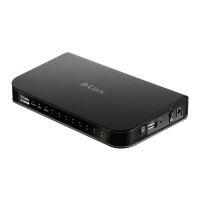D-Link DSR-Series User Manual 71
Section 5 - Connect to the Internet
RIP
Dynamic routing using the Routing Information Protocol (RIP) is an Interior Gateway Protocol (IGP) that is
common in LANs. With RIP this router can exchange routing information with other supported routers in the
LAN and allow for dynamic adjustment of routing tables in order to adapt to modications in the LAN without
interrupting trac ow.
Note: The DSR-150/150N/250/250N routers do not support RIP.
Path: Network > Routing > RIP
To congure RIP:
1. Click Network > Routing > RIP.
2. Complete the elds in the table below and click Save.
Field Description
Direction
The RIP direction will dene how this router sends and receives RIP packets. Select one of the
following:
• Both: The router both broadcasts its routing table and also processes RIP information received
from other routers. This is the recommended setting in order to fully utilize RIP capabilities.
• Out Only: The router broadcasts its routing table periodically but does not accept RIP
information from other routers.
• In Only: The router accepts RIP information from other routers, but does not broadcast its
routing table.
• None: The router neither broadcasts its route table nor does it accept any RIP packets from
other routers. This eectively disables RIP.
Version
The RIP version is dependent on the RIP support of other routing devices in the LAN.
• Disabled: This is the setting when RIP is disabled.
• RIP-1: A class-based routing version that does not include subnet information. This is the most
commonly supported version.
• RIP-2: Includes all the functionality of RIPv1 plus it supports subnet information. Though the
data is sent in RIP-2 format for both RIP-2B and RIP-2M, the mode in which packets are sent
is dierent. RIP-2B broadcasts data in the entire subnet while RIP-2M sends data to multicast
addresses.
Note: If RIP-2B or RIP-2M is the selected version, authentication between this router and other routers
(congured with the same RIP version) is required. MD5 authentication is used in a rst/second key
exchange process. The authentication key validity lifetimes are congurable to ensure that the
routing information exchange is with current and supported routers detected on the LAN.
Save Click Save to save your settings.

